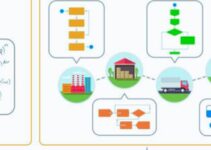IKEA is a retail chain of ready-to-made furniture, home accessories, and kitchen appliances manufacturing Swedish multinational conglomerate. Ingvar Kamprad founded the furniture brand in 1943; the company has established a network of approximately 462 retail chain ready-to-made furniture stores in various countries across the globe. Today, we’ll discuss the supply chain analysis of IKEA; it focuses on various SCM elements like procurement planning, inventory management, warehousing, automation, transportation, and distribution.
Supply Chain Analysis of IKEA
Let’s discuss the main elements of the supply chain analysis of IKEA are as follows;
Suppliers Network
IKEA has established a very large network comprising approximately 1800 suppliers and vendors in over 50 countries across the globe. The furniture brand has set up 42 trade service offices in various countries to maintain a professional relationship with the suppliers. The company focuses on building a long-term relationship with various suppliers to ensure the smooth availability of raw supplies and materials at the lowest possible prices.
In order to motivate suppliers, vendors, and wholesale partners, IKEA has set up strict guidelines and code of conduct for suppliers and it goes by the name of “IKEA way of purchasing home furnishing products.” It allows you to decrease the price and improve the quality standards by making the furniture more affordable and accessible to ordinary customers.
Assembling
The interesting and unique feature of IKEA’s feature is its easy assembling and ready-to-made by ordinary customers. The company sells its furniture in small pieces that can easily fit into the small and flat package. However, it allows the company to save transportation costs and efficiently utilize the space; because the small and flat pieces take up limited space in the truck.
The brand could ship, store, and transport more products and goods at the same cost and space. In fact, the shipping of most of the company’s products is directly from the suppliers’ facility and manufacturing partners to the retail chain stores; it decreases the storage, warehousing, and inventory costs.
Recyclable Material
One of the main reasons behind the low production and shipping costs of IKEA’s furniture is that the company employs recyclable and sustainable materials for the production of furniture and home accessories. However, it allows you to procure the new limited materials, supplies, and resources for the production of new parts and shipment.
Warehouse Management
IKEA hires logistics managers for its retail chain stores. They have the responsibility of managing inventory-related processes ranging from allocating products and goods at the right location, organizing and separating products and goods, and analyzing and evaluating deliveries. However, every IKEA has a showroom on the upper floor and warehouses on the ground floor and they have the capability of storing over 9500 product pieces and stock at the store.
The company showroom allows customers to see and feel the experience of its furniture. Every furniture piece would have a separate article number, aisle, and bin number. Customers could easily find the required product piece in the warehouse. However, the store owners and shoppers can’t access one-third of the warehouse, because it is for the massive and bulky furniture items and they require the assistance of their staff and workers.
Inventory Management
Effective and efficient inventory management would help the company to quickly adapt to the changing market conditions and demands. IKEA employs automation technology and advanced data analytical tools to ensure the optimum inventory level, which helps the company decrease stockouts. However, the company automates the restocking of the high-flow items, the logistics managers manage the in-store logistics and the company maintains the supply chain fulfillment with limited disruption.
The flat packing of IKEA’s furniture and self-service furniture has made the low-cost inventory turnover possible along with decreasing the transportation cost. The lean and agile inventory management would help IKEA to achieve supply resilience and efficiency.
Reordering Areas
IKEA has an advanced inventory management system, which helps the furniture brand maintain the limited products available before reordering. It helps the company to recognize the perfect reorder point and avoid understocking and overstocking. However, the logistics managers become aware of the sold item; and the amount of inventory that entered the store via direct shipment from the distribution centers.
They employ the key information for sales forecasting before time and reorder the stock of products and goods to meet the demands of customers in the upcoming season. If the actual sale won’t match the forecasted sale data, then the logistics management manually analyzes the stock.
Automation
IKEA has divided its warehousing facility into manual facilities slow selling and automated facilities for fast selling. It helps the company to decrease the managing cost for low-demand products and ensures the smooth flow of high-demanded products and goods.
Conclusion: IKEA Supply Chain Analysis | IKEA Supply Chain Management
After an in-depth study of the supply chain analysis of IKEA; we have realized that IKEA is the world’s leading furniture retail chain brand. If you are learning about the IKEA supply chain analysis; then you should keep in mind the abovementioned SCM elements; procurement, planning, transportation, automation, inventory management, and sortation.
Ahsan is an accomplished researcher and has a deep insight in worldly life affairs. He goes Live 3 days a week on various social media platforms. Other than research writing, he’s a very interesting person.


